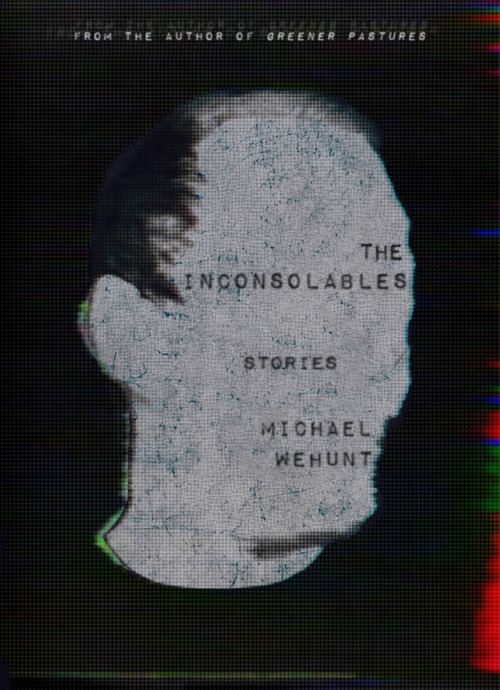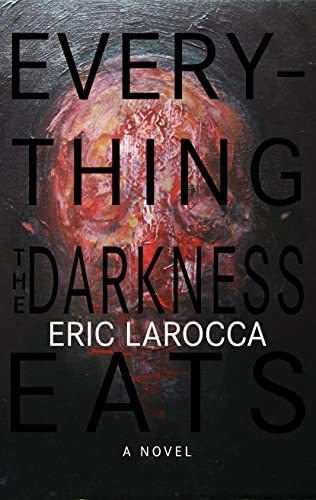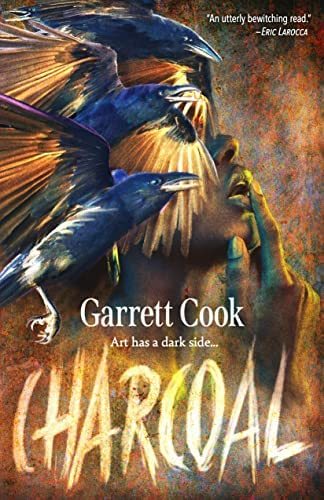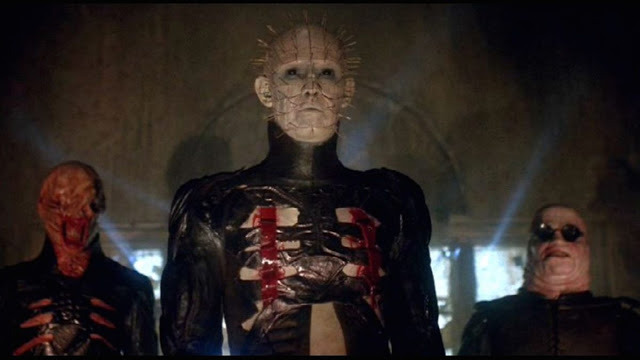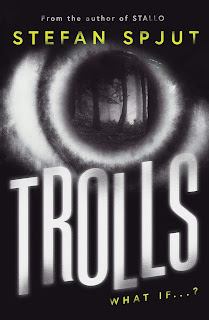Obviously, this post will contain spoilers for
Hellraiser.
This is the story of how a pissing match in a dorm lounge started a tradition I’ve kept in place for over a decade.
Every Valentine’s day since 2009, I’ve gotten drunk and watched
Hellraiser. It’s usually a solitary exercise, I haven’t had any want or desire for partnership since July of 2010*, but if anyone wished to join me, they would of course be welcome. It’s been an annual tradition, usually involving the imbibing of several Dark and Stormys, a drink I became quite fond of at college, and since college is the whole reason I do this thing in the first place, it’s a little bit of nostalgia and a small taste of a time I once called home. The rum may be better quality (ever since Captain Morgan changed the recipe on Private Stock it just hasn’t been the same) and the ginger ale might be lower quality (It’s difficult to get sugarcane colas at a goddamn Shop-Rite, okay?), but it’s a connection to something important. And it’s a way of striking back at people who tried to force their interpretation of love on to others, a way of showing that there are multiple forms of romance, and that even the darkest movies can be about painfully human subjects.
Even if I was, as this story kind of illustrates, a prick.
On the top floor of La Salle Hall at the College of Santa Fe was the LaSalle Lounge. It wasn’t much overall, just a wall-mounted TV, a couple of huge heavy-ass comfy chairs and a couch made of scratchy fabric and gigantic wood blocks, a dining-room table, and a microwave. But the TV came with an A/V input, and a bunch of us had game systems and DVD players and the like, so it became kind of a prime hangout spot for the residents and their friends. It was also safe enough and familiar enough that if you put your game system or something in the lounge, there was a high chance you didn’t also have to build a metal cage around it to protect it**. There are a lot of good memories I have of that time, some of my favorite memories of watching movies are tied deeply to sitting in huge scratchy dorm-lounge chairs. It wasn’t perfect, but it was nice.
At first, claiming the lounge was a first-come first-served affair, but due to several incidents involving people who weren’t residents occupying the space with their friends, and due to an incident where an unnamed party decided to announce about a week or two in advance that they were showing Peter Jackson’s classic family drama
Dead-Alive and posted handwritten signage to that effect, one forward-thinking resident put up a signup sheet for the lounge and TV. It gave a sense of schedule and people got advance warning if, say, several people from the lower floor were going to show an awful romance film called
Angst*** that they picked up from the local Hastings for twenty bucks. By and large, most people played by the loose social contract the signup sheet presented– there were always a few changes and cancellations and “hey, we need the room” sort of things, but the boundaries were respected, and those transgressors (who, I admit, I numbered among briefly) were rare. It also gave a good view of what was going on, so if you knew someone was watching, say,
The Land Before Time synced up with
In Rainbows by Radiohead as an ironic goof that still sorta vaguely worked, you could either show up, or avoid the upstairs like the plague.
So, scene all set? Good, then let’s begin.
My friend Geoff was kind of a complicated figure. He was wildly philosophical, but also tended to do the thing where he tried to apply the specific strains of thought he learned to absolutely everything, to the point that he’d get in arguments all the time about whatever he’d read or learned at that particular moment. He was a person I’d had no less than three arguments about
Lost Highway with, but he was also one of the few people I knew on campus who would watch trashy movies with me and try to appreciate them without irony (the best way to watch
Urotsukidoji is in the middle of the afternoon on your roommate’s mini-tv while complaining about the censor blur). He overintellectualized things, sometimes a lot, but at his heart, he was a good guy. Because of our shared taste in trashy and weird movies (it’s through him that I finally saw
Caligula and found it was everything I wanted and some sex scenes I didn’t) and the residency status I had and he didn’t, he would often get me to claim the lounge for whatever weird thing he wanted to watch. I didn’t mind, because usually he could draw a better crowd and his choices were a little more acceptable than mine. (
Never spring
Aeon Flux on people who don’t already want to watch
Aeon Flux. That’s your lesson for today.) He also had an unmatched passion for everything, when he hooked into something, he really hooked into it, deciphering it and deep-diving into it like it was a sacred text, trying to take it apart and figure out why he liked it so much.
He also had his troubles with women.
Between 2007 and 2008, Geoff bounced between bad breakups and some interesting coping mechanisms to try and gain some semblance of catharsis, vanishing down rabbit hole after rabbit hole of weird film theory, music theory, and experimentation. Not all of it was particularly well received, and a few things he proposed were wildly off-base and caused at least one shouting match in a Del Taco, but I felt for the guy, because he was really trying to get a grip. He needed people and a way to cope, and his normal approach was failing. For him, his solace was in figuring out how things worked, applying his own philosophical bent or ideas about the world to the things around him and trying to work his way through, the same way some people do with martial arts, or religion, or whatever you have. You find the thoughts and concepts to get you through the day, to help the world make sense to you. His might have taken him to some dark places and included drinking tons of vodka, but, again, he was a good friend. He was hurting in a bad way, and he needed help working through it.
In hindsight, a lot of my behavior during that period was most likely enabling, but I meant well and I was trying to help someone out of a dark place.
After a rather nasty social entanglement imploded on Geoff early in 2008 when he decided to get involved with
exactly the wrong person, he was again in a dark place. Even I was starting to get a little weary of it as it had become self-destructive to the point of dragging me into the singularity, and of continually having to defend Geoff’s choices, which he foisted on our mutual friends without much care to what he was saying. In those days, while many of us would be loath to admit it, we were all so sure and certain of our choices and resolute in our refusal to back down from them. It was just that Geoff took it way too far. And in this dark place, Geoff had an idea that would become the basis for a decades-old tradition.
One day, about a week or so before Valentine’s Day, Geoff came to me and told me, “Know what? Fuck it. We’re gonna watch
Hellraiser this Valentine’s.” For once, I was immediately on board. I’ve always been a huge proponent of non-trad genre distinctions, from
calling Dune an epic fantasy novel, to my early-adopter status on the “
Die Hard is a Christmas movie and so is
The Long Kiss Goodnight” argument (I know it probably had its supporters pre-2003, but I argued for it hard and it still seemed novel back then), to even
this blog’s long-ass article on Fight Club. So
Hellraiser as Valentine’s Day watching? Sure it was a little bit of a dark choice, and sure it was a gruesome movie to watch on a holiday that’s normally a celebration of love, but there’s some insight there, and I was always down for a reason to watch Clive Barker. I’d gone off of Stephen King for a while after
The Stand and loved the “melancholic lyricism but also everyone bangs” vibe Barker laid down in most of his work.
So naturally, I said yes. Why wouldn’t I? I put my name, time, and title of the movie down on the signup sheet in the lounge, and figured that would be the end of it. I’d hang with my friend, we could shit-talk love because we were both on the wrong end of things, and watch a movie that’s romantic for all the weirdest reasons.
Then midway through the week, things changed. By that time, Geoff wasn’t well-received, and my film picks were seen as an extension of his ideas and choices, which did not jibe well, especially since I wasn’t all that popular myself with contingents of the dorm for a variety of reasons****.
When I mentioned I had plans, then one of my friends suddenly went, “Oh…yeah, we didn’t want Geoff pushing his ‘screw love it’s all horrible’ thing, so we crossed that out and we’re gonna watch a bunch of romantic comedies instead."
”…but I wanted to watch
Hellraiser. And it’s a romantic movie.“ I responded. "It’s not about how love is evil.”
“Yeah, but…it doesn’t fit with the holiday and Geoff was just trolling, so this is better."
I protested that it wasn’t Geoff who made the decision but me, tried to explain my reasons, and even offered to change the movie as long as I could keep the spot, but there really wasn’t anything that could be done. Complete shutout because "it would be better.” It seemed like both me and my friend wanted to end the awkward conversation, so I had to drop the issue. When the day finally came around and I was there, someone even stood there and announced how much time everyone had left in the lounge almost every five minutes for a solid
hour before they took over, and kicked everyone out so that somehow we wouldn’t ruin their viewing of
13 Going On 30^.
But they were wrong.
Hellraiser is a romantic film, and one
exclusively about love. Let me explain.
Hellraiser is the story of Julia, a woman who moves into the old house of her former lover Frank with her husband and stepdaughter. Frank mysteriously disappeared after an encounter with an ancient puzzle box called the Lemarchand Configuration, and now he’s gone and presumed dead, his house an unsettling wreck of narrow interiors and dark rooms. Julia’s husband Larry, Frank’s brother, is a doofy good-natured and oblivious sort who wanted to move his wife back to her home country and hopes to strengthen their relationship. With them is Larry’s daughter Kirsty, who moved so she could be closer to her parents and possibly learn to get along with her stepmother. While they’re moving into Frank’s house, Larry cuts himself in an accident and drips blood on the stairs, something that stirs the previously trapped spirit of Frank and allows him to contact Julia and beg her to spill more blood in the house so he can live again. Meanwhile, Kirsty is disturbed by both the house and her stepmother’s odd behavior in hiding Frank, and begins to have encounters with a homeless vagrant who looks like the lawyer-friendly version of Alan Moore, and a mysterious puzzle box.
Right away, that’s the structure of a gothic romance. You have infidelity, an old dark house, a ghostly or demonic lover, weird artifacts, and a subtle hint of classism. Julia’s a villain, but she’s only a villain because of her obsessive love and a desire to right the wrongs of her now almost-dead lover. It’s Larry’s obliviousness that continues to isolate him from his wife’s repeated awful misdeeds with Frank, believing that she’s faithful and they’re still in love even when it’s obvious to the audience that she views him as an empty suit. And Kirsty, the one mostly “pure” person in the whole movie and definitely the one innocent, slowly grows in importance to the plot as she tries to piece everything together. It’s Victoriana updated for the modern era, pitting the young woman against a house full of ghosts and wicked stepmothers, but somehow in a much more humanizing light. Julia’s trapped by everyone, by Frank’s obsessive need for resurrection, by her lack of maternal status in Kirsty’s eyes, by Larry taking her for granted.
It’s also telling that it’s the unhealthy relationships that cause all the deaths in this movie. It’s established practically from the outset that Julia and Larry don’t have the best relationship, and she was much happier with Frank, to the point of moving back into his house with him. It’s that obsession and love that drives their toxic relationship, as Frank seems to see her as nothing more than a useful necessity, someone he needs to bring him blood and skin so he can finally escape the prison he was trapped in by the box. Meanwhile she believes what they had was truly love. Frank and Kirsty even have a shadowy but heavily implied past that doesn’t exactly cast Frank in the best light and only further shows exactly how monstrous and uncaring towards everyone else he truly is. Julia and Larry fail to work on their marriage even a little, which drives Julia further into Frank’s arms and away from her husband, who appears to not even care if she’s in the room at times. All these toxic relationships even come crashing down in the finale when Kirsty, the one person who displays empathy towards others, manages to set up a desperate gambit with the box, finally bringing everything to its explosive and inevitable conclusion where all the toxicity finally burns itself out.
Hellraiser is about love because it’s Kirsty’s love for her father that keeps driving her to investigate her stepmother, because it’s Julia’s lack of love and intimacy that drives her to literally murder people, because it was Larry’s love and desire to support his wife and his failing marriage that put them in Frank’s old dark mansion to begin with. It’s a cautionary tale, a morality play about unhealthy relationships and chasing sensation over actual feeling and empathy. It’s about pain, infatuation, obsession, and loss. It might go about it in a gory, effects-heavy, and surprisingly fish hook-happy way, but it’s a tragic romance sure and certain as any other tragic romance out there, even if it’s nontraditional. A human story is a human story, even if it involves a switchblade-wielding zombie and a man with his lips and eyes cut out, after all.
So for those reasons, and because it’s an amazing movie and the one correctly rated entry in Clive Barker’s filmmaking career, every February 14th, while the rest of the world settles in with classic love stories and whoever makes them happiest, I pour myself a glass of rum and ginger ale. I pour myself a glass for Geoff and all those like Geoff, caught in a vortex of bad relationships and not-great thought patterns, and desperate to get out^^. I pour myself a glass for myself, never exactly sure where I stand romantically but terrified I’ll end up in that same vortex before I’m able to escape, and knowing I’m too old to keep trying. I pour myself a glass against the people who stopped me, as petty as that is, because I know in my heart and in my head and in my G
od. Damn. Soul. that they were wrong about love and wrong about
Hellraiser. In my pettier moments, I hope they still are.
And this has happened every year since 2010, and I hope it still will. I hope it continues long past everyone who stood against that first viewing. I hope other people pick up on the trend and it outlasts and outlives us all. And I hope people realize that romance and romantic films aren’t necessarily what everyone thinks they are. To paraphrase a former friend of mine, genre’s fake anyway.
So that’s the story. It’s overlong, it’s not exactly charitable, but it’s a tradition. In honor of all those things, I’ll proudly raise a glass this Valentine’s day and every day after. Hope you enjoyed this, and hope you do it, too.
Goodnight.
*My second-ever relationship ended in a rather depressing dissolution that was as much my fault as the other party’s, and showed me that I was too emotionally immature to handle intimacy and the work that goes into romance. I promised my then-partner I would be alone from that point on, and in spite of several incidents I don’t wish to discuss, I have tried to keep to that as best as I possibly can. While I do get lonely and I do have needs, I also don’t want anyone to have to experience me.
**The other dorms taught me the important lesson that maybe this wasn’t the case everywhere on campus, and much thanks to my friend CMC for both fixing that and the chair I ended up stripping the screws on somehow
***Two and a half stars from the now-defunct Absolute Horror, and a premise that’s shitloads ahead of its execution
****Being cringey, obnoxious, and generally making wildly explicit comments (while not about anyone in particular, still) will do that to you. By that point I’d had an identity of my own for maybe five years, tops, and the idea I could be confident and in control of my own identity and go to bed whenever I wanted all kinda went to my head, as well as finally living unrepressed for about two years. All of this informs my behavior. It doesn’t excuse or absolve it. I’d get into it more, but why add fuel to the dumpster fire?
^Ironically, a movie I have a small amount of fondness for ever since I watched it with my sister back when we were teenagers
^^I know I’ve been using the past tense here about Geoff. I’d like to report that he’s still alive and completely well as far as I can tell. We drifted apart years ago over a rather significant and irreconcilable difference of opinion. Writing this, I actually kind of miss him, the obstinate dingus.
